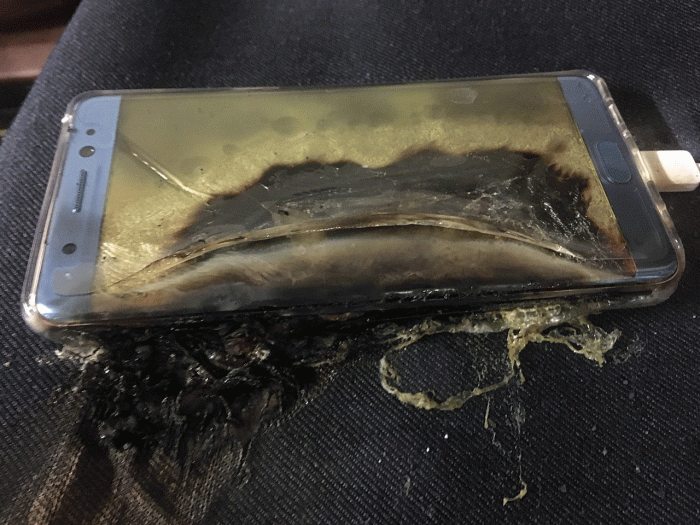The Samsung Galaxy Note 7 Recall
The Samsung Galaxy Note 7 recall was a major event in the history of the smartphone industry. It involved the recall of millions of devices due to a battery defect that caused them to overheat and catch fire. The recall had a significant impact on Samsung’s reputation, brand image, and financial performance.
Timeline of the Note 7 Recall
The Note 7 recall unfolded in a series of events, starting with reports of exploding devices and culminating in the discontinuation of the device.
- August 2016: Reports of Note 7 devices catching fire begin to emerge. Samsung initially dismisses these reports as isolated incidents.
- September 2, 2016: Samsung announces a global recall of the Note 7, citing a battery issue. The company urges users to stop using the devices and exchange them for a new one.
- September 9, 2016: Samsung begins shipping replacement Note 7 devices, claiming they have addressed the battery issue.
- September 19, 2016: Reports of exploding replacement Note 7 devices begin to emerge. Samsung suspends production and sales of the Note 7 again.
- October 11, 2016: Samsung officially discontinues the Note 7 and announces that it will no longer produce or sell the device.
Impact on Samsung’s Reputation and Brand Image
The Note 7 recall had a significant negative impact on Samsung’s reputation and brand image. The company faced widespread criticism for its handling of the recall, with many accusing it of being slow to react and of downplaying the severity of the issue. The recall also damaged Samsung’s image as a reliable and trustworthy brand, particularly in the eyes of consumers who had experienced the problems firsthand.
Financial Implications of the Recall
The Note 7 recall was a costly affair for Samsung. The company estimated that the recall would cost it billions of dollars in lost revenue, production costs, and replacement costs. In addition, the recall damaged Samsung’s stock price and led to a decrease in investor confidence.
Causes of the Note 7 Explosions
The Samsung Galaxy Note 7 faced a major crisis due to widespread reports of its batteries catching fire and exploding. While Samsung initially blamed the issue on a manufacturing flaw, investigations revealed that the root cause was a deeper design flaw in the battery itself.
Battery Design and Manufacturing Flaws
The Note 7’s battery design was the primary culprit behind the explosions. Samsung used a battery with a slightly larger capacity than its predecessor, the Note 5, but the space within the phone remained the same. This meant that the battery cells had to be thinner and more tightly packed. This design choice, coupled with manufacturing flaws, led to several issues that ultimately resulted in overheating and combustion.
The battery’s design and manufacturing flaws led to a cascade of events that resulted in overheating and combustion.
- Battery Cell Design: The Note 7 battery used a stacked design, where multiple battery cells were layered on top of each other. This design, while common in smartphones, can be prone to overheating if not properly engineered and manufactured. The tightly packed cells could cause heat to build up and spread more easily, leading to thermal runaway.
- Manufacturing Flaws: Samsung’s battery manufacturing process had several flaws that contributed to the explosions. One key flaw was the use of a “separator” material between the battery’s positive and negative electrodes. This material is crucial for preventing a short circuit, but in the Note 7, the separator was too thin and easily punctured, leading to direct contact between the electrodes and a rapid increase in temperature.
- Battery Size: The Note 7’s battery was designed to have a larger capacity, but it was crammed into the same space as the Note 5’s battery. This forced the battery cells to be thinner, increasing the risk of internal pressure buildup and potential damage to the separator.
The Note 7 and Vehicle Fires
The Samsung Galaxy Note 7, while a technological marvel in its time, unfortunately, became infamous for its battery issues, leading to numerous incidents of overheating and explosions. These incidents weren’t confined to individual users’ pockets or homes; they also extended to vehicles, creating a serious safety hazard.
The combination of a faulty battery and the enclosed environment of a car could create a dangerous situation. The Note 7’s battery, when defective, could overheat rapidly, potentially igniting the surrounding materials. This is particularly alarming in a vehicle where the Note 7 might be left on a seat, in a cup holder, or even in a charging port.
The Note 7 and Vehicle Fires: A Closer Look
The potential risks of using a Note 7 in a car are multifaceted. The enclosed environment of a vehicle, coupled with the heat generated by the sun, could contribute to a significant rise in the phone’s internal temperature, potentially exceeding the battery’s safe operating range. Furthermore, the vibrations and jolts experienced during driving could exacerbate battery issues, leading to internal short circuits and ultimately, fires.
Here are some examples of incidents where Note 7 devices caused fires in vehicles:
- In September 2016, a woman in South Korea reported that her Note 7 caught fire while charging in her car. The fire caused significant damage to the vehicle’s interior.
- In October 2016, a man in the United States reported that his Note 7 exploded while in his car, causing a small fire. The fire was quickly extinguished, but the incident highlights the potential danger of using a Note 7 in a vehicle.
- In November 2016, a woman in the United Kingdom reported that her Note 7 caught fire while she was driving. The fire spread quickly, forcing her to pull over and evacuate the vehicle. The incident resulted in significant damage to the car.
These incidents serve as a stark reminder of the dangers associated with using a Note 7 in a vehicle. The enclosed environment of a car can trap heat and increase the risk of a battery malfunction, leading to a fire. It is crucial to remember that even if the phone appears to be functioning normally, there is still a potential risk of fire.
Safety Measures and Recommendations
The Samsung Galaxy Note 7 debacle was a stark reminder of the importance of battery safety in electronic devices. In response to the widespread incidents, Samsung took several steps to address the issue and prevent future occurrences. Furthermore, there are several precautions smartphone users can take to mitigate the risk of battery-related issues.
Samsung’s Safety Measures
Samsung’s response to the Note 7 explosions was comprehensive and multifaceted. They immediately launched a global recall of the affected devices, halting production and sales. They also implemented stringent quality control measures in their manufacturing processes to prevent similar issues from arising. Samsung conducted thorough investigations to pinpoint the root cause of the explosions and implemented design changes to address the underlying issues.
Smartphone Battery Care and Usage, Note 7 explosion vehicle on fire
The Samsung Note 7 incident underscored the importance of responsible battery care and usage practices. Following these recommendations can help minimize the risk of battery-related issues in smartphones:
- Use Original Chargers: Using chargers that are not specifically designed for your device can damage the battery and increase the risk of overheating or explosions.
- Avoid Overcharging: Leaving your phone plugged in for extended periods after it has reached 100% charge can stress the battery and shorten its lifespan.
- Do Not Use Damaged Batteries: If your battery is damaged, swollen, or shows signs of leakage, replace it immediately.
- Avoid Extreme Temperatures: Extreme heat or cold can damage your battery. Avoid exposing your phone to direct sunlight or extreme temperatures.
- Regularly Update Software: Software updates often include battery management improvements that can enhance battery performance and safety.
Consumer Awareness and Education
The Samsung Note 7 incident highlighted the need for increased consumer awareness and education regarding battery safety. Consumers should be informed about the potential risks associated with using faulty batteries and how to identify signs of battery damage. Educating consumers about responsible battery care practices and the importance of using certified chargers can help prevent similar incidents in the future.
Lessons Learned from the Note 7 Recall: Note 7 Explosion Vehicle On Fire
The Samsung Galaxy Note 7 recall was a major event in the mobile phone industry, and it led to a significant shift in how companies approach product safety and quality control. The recall highlighted the importance of rigorous testing, robust quality control processes, and open communication with customers.
Impact on the Mobile Phone Industry
The Note 7 recall had a significant impact on the mobile phone industry as a whole. It led to a renewed focus on battery safety, with manufacturers investing in more rigorous testing and quality control processes. The recall also highlighted the importance of open communication with customers, as companies realized that transparency and prompt action are essential in crisis situations.
Changes in Battery Safety Standards
The Note 7 recall led to significant changes in battery safety standards. The industry adopted stricter testing procedures, including more rigorous cycle life testing, and introduced new safety features such as pressure sensors and overcurrent protection.
The industry also moved away from using high-density batteries, which were considered more prone to overheating and explosions.
Improvements in Quality Control Processes
The Note 7 recall led to improvements in quality control processes across the mobile phone industry. Manufacturers adopted more stringent testing procedures, including increased use of automated testing and more thorough visual inspections. They also implemented more robust quality control systems, such as multi-level checks and increased supplier oversight.
Enhanced Product Testing Procedures
The Note 7 recall highlighted the importance of comprehensive product testing. The industry adopted more rigorous testing procedures, including extended stress tests and more realistic simulations of real-world use cases. They also increased the number of test cycles and implemented more robust failure analysis procedures.
Note 7 explosion vehicle on fire – The Note 7 saga is a cautionary tale for both consumers and manufacturers. It highlights the critical importance of rigorous testing and quality control, especially when dealing with powerful lithium-ion batteries. The Note 7’s fiery demise serves as a reminder that even the most advanced technology can be vulnerable to unforeseen issues. It’s a reminder to always be aware of the potential risks associated with our devices, and to take steps to ensure our safety and the safety of those around us. While the Note 7 is gone, its legacy continues to shape the mobile phone industry, pushing manufacturers to prioritize safety and transparency in their products.
Remember the Note 7 saga? The phone that was so prone to exploding, it even set a car on fire. But the most terrifying story might be the one where a Note 7 exploded in the hands of a 6-year-old. Thankfully, the kid was okay, but the incident serves as a chilling reminder of the potential dangers of faulty tech.
The Note 7’s legacy isn’t just about fiery phone cases; it’s about the importance of safety and the devastating consequences when it’s ignored. It’s a story that reminds us that even the most advanced technology can be a ticking time bomb if not handled with care.
 Standi Techno News
Standi Techno News

